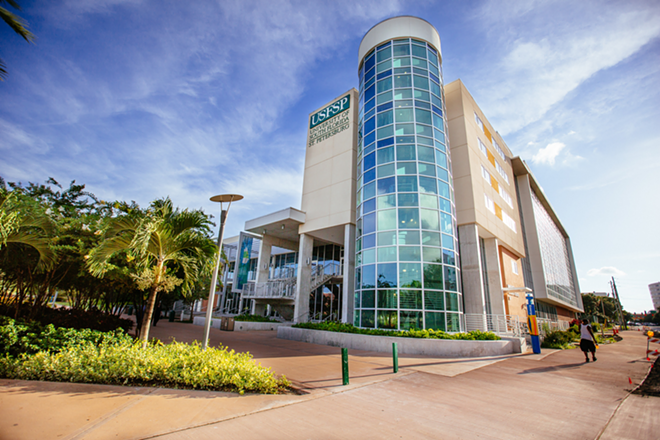“History doesn’t repeat itself, but it rhymes.” Mark Twain may or may not have first uttered the phrase, but recent events underscore the quote’s truth. In rapid succession, USF Tampa succeeded in a power grab to derail USFSP’s dreams of independence and autonomy, followed by the announcement that the USF Sun Dome will henceforth be known as the Yuengling Center. Beer trumps solar!
Gadflies snicker that the St. Petersburg campus will become a Top of the World retirement community, and that the Sun Dome, now associated with the Yuengling Brewery, should more properly be named the Foam Dome, the Suds Dome and House of Brews.
Novelists and journalists love a great rivalry: Paris and London, St. Louis and Chicago, and Tampa and St. Petersburg. Since the founding of the twin cities on Tampa Bay in the 19th century, Tampa and St. Petersburg have sparred over urban, economic and academic supremacy.
But the current guffaws are not nearly as funny, nor are the stakes as serious as the insults of an earlier generation. Today, an Era of Good Feelings exists between the two great cities on opposite sides of Tampa Bay. It was not always so. In the half-century following WWII, the Tampa Tribune and St. Petersburg Times fought surrogate wars over regional airports, water rights, highway routes and professional sports franchises.
In the early 1950s, a bitter battle was fought over who would/should secure control of Tampa Bay’s first VHF (very high frequency) television station. Since newspapers owned the major radio stations, it seemed logical that they would also own the emerging TV stations.
A long-lasting feud between the Times and Tribune intensified when Governor Fuller Warren entered the fray. The governor loathed both papers. Warren thought the Tribune’s managing editor, Virgil “Red” Newton, was a “neurotic screwball,” and was concerned that “foreign owners” (a Virginia syndicate!), controlled the paper.
The Times’ liberal leanings also flummoxed the governor. He swore that everyone from the paper’s copy boys to editors were card-carrying members of the Communist Party. The Tampa Tribune won the skirmish: WFLA debuted in 1955.
But no battle drew more blood or raised more hackles than the location of a new public university. In the postwar years, Florida was bursting with new residents, but the Florida legislature struggled to modernize its higher education system. No four-year public university existed south of Gainesville. By the mid-1950s, legislators had decided Tampa Bay would be home to the university.
Only one question remained: Tampa or St. Petersburg? Tampa held many advantages. The press had a field day caricaturing rivals. “St. Petersburg?” wrote Leland Hawes, a Tribune reporter. “Why, it’s filled with retirees lounging around on green benches waiting to plop into the nearest grave.” The Tribune also expressed concerns that students would run down elderly pedestrians crossing downtown streets in search of early-bird specials.
St. Petersburg’s greatest handicap was not age but politics. St. Petersburg and Pinellas County were foursquare Republican at a time in Florida when most state legislators were yellow-dog Democrats — they’d rather vote for a yellow cur dog than a Republican! St. Petersburg could not match powerful State Senator Sam Gibbons (D-Tampa) and his steadfast efforts to bring home the pork. Still, St. Petersburg managed to hurl insults at its competitor.
“Tampa?” wondered a Times reporter. “Wouldn’t go near there! It’s just a little Chicago. You could be shot!” The Times also scoffed at the proposed site on Fowler Ave. The campus was so close to the nearby Schlitz Brewery that the school might as well be branded “Bottlecap U.” Another editorial called the would-be campus “Brew U.” In October 1956 the Times cautioned, “This site would require coeds and young men to pass through Tampa’s worst section, the hard core of the city’s crime and gambling and vice…”
In a desperate attempt to persuade the State Board of Control, the St. Petersburg Ministers’ Assoc. opposed the Temple Terrace site because it was uncomfortably close to the Schlitz Brewery. A resolution addressed the problem, beseeching the board to “take note of the impending erection of a large brewery adjacent to a proposed site of the new university in Hillsborough County.”
We live today in a world turned upside down. The Tampa Tribune has vanished, the St. Petersburg Times has morphed into the Tampa Bay Times, and the City of St. Petersburg has encouraged the Tampa Bay Rays to cuddle up to Hillsborough County commissioners.
I miss the golden age of newspapers and the old Schlitz factory. That factory, once perilously close to USF, is now occupied by the Yuengling brewery, comfortably close to the USF Yuengling Center. I also miss the fierce urban rivalries.
When the 1906 earthquake laid waste to San Francisco, a reporter asked musician Eugene Schmitz why the sister city of Oakland was spared. He replied smugly, “There are some things even the earth won’t swallow!”
________________
Gary R. Mormino taught history on the USF Tampa and St. Petersburg campuses for four decades. In 2015, he was awarded the Lifetime Achievement Award for Writing by the Florida Humanities Council.


